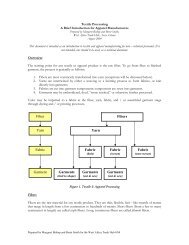Shea Butter A Guide to Production and Marketing - AGOA Export ...
Shea Butter A Guide to Production and Marketing - AGOA Export ...
Shea Butter A Guide to Production and Marketing - AGOA Export ...
You also want an ePaper? Increase the reach of your titles
YUMPU automatically turns print PDFs into web optimized ePapers that Google loves.
Peace Corps Ghana Version 1, March 2008<br />
1: The Biology of <strong>Shea</strong><br />
Where do <strong>Shea</strong> trees live?<br />
Ghana is lucky. Ghana <strong>and</strong> Burkina have the best shea butter in the world. Why?<br />
Because the shea nuts here have the most desirable chemical balance, <strong>and</strong> the<br />
traditional processing methods create a very clean butter.<br />
The shaded areas depict rainfall values. The small grey dots show areas of shea trees<br />
(Vitellaria paradoxa) in West Africa. The white dots are a different variety of shea<br />
trees in East Africa.<br />
Life Cycle<br />
As deforestation becomes a bigger problem in Ghana, the availability of shea nuts <strong>and</strong><br />
butter is directly impacted. Bushfires, cutting of trees for firewood <strong>and</strong> destructive<br />
farming methods are all fac<strong>to</strong>rs that affect the availability of shea nuts. Currently,<br />
local people <strong>and</strong> NGOs are more interested in protecting <strong>and</strong> cultivating shea trees.<br />
Underst<strong>and</strong>ing the life cycle of shea is essential <strong>to</strong> the survival of the shea butter<br />
business.<br />
The number of years for a tree <strong>to</strong> reach maturity, <strong>and</strong> therefore produce fruit, is up for<br />
debate, but it is generally accepted <strong>to</strong> be 3-5 years. Many people will argue that it<br />
requires 15 or even 20 years <strong>to</strong> fruit, but ask them how many trees they have planted.<br />
Information on lifespan of shea trees is sparse.<br />
The shea fruit is generally ripe from mid-May through the end of July. There is some<br />
variation due <strong>to</strong> location <strong>and</strong> rainfall. The fruit is edible <strong>and</strong> tasty. Mature nuts come<br />
from fruits that have fallen <strong>to</strong> the ground, so women will forage for fallen fruit, either<br />
Page 4 of 28









